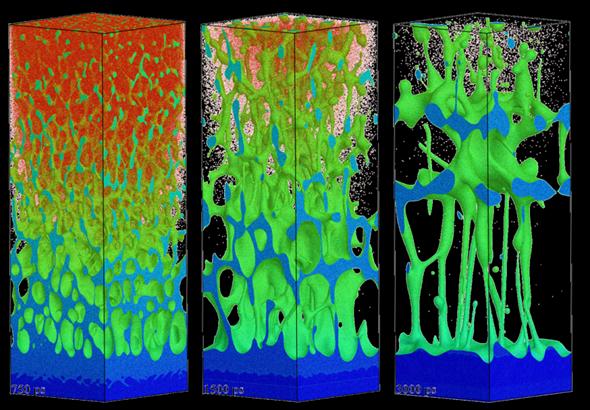If the movie The Graduate were remade in 2018, the famous one-liner “plastics” might be replaced with two words: metal nanoparticles, tiny materials that are proving to be widely useful.
“Silver nanoparticles, for example, are important for biomedical applications,” says Leonid Zhigilei, a professor of materials science and engineering at the University of Virginia. “You can attach some molecules to your nanoparticles and then guide them to cancer cells and kill them.”
Researchers can synthesize these particles easily and cheaply, Zhigilei says. “But then you have contamination due to the process” that can limit or negate the nanomaterial’s desired effects. So instead of building nanoparticles from scratch, Zhigilei proposes peeling layers off the metal surface. Using laser ablation, which removes material by melting or evaporation, researchers can produce what they consider clean nanoparticles, with defined and controlled compositions.
But there’s the rub: Laser pulses on metals produce complex and poorly understood reactions. To sort out those complexities, Zhigilei’s computational materials group has been simulating silver nanoparticles and other technologically important phenomena on the Titan supercomputer at the Department of Energy’s (DOE) Oak Ridge Leadership Computing Facility, a DOE Office of Science user facility in Tennessee. The research is revealing how short laser pulses on these metal surfaces produce elaborate, multiscale, flowing features and instabilities.
The work has been supported since 2016 with 40 million processor hours on Titan through DOE’s INCITE program (for Novel Computational Impact on Theory and Experiment). Last year Zhigilei and his colleagues described their simulations of laser pulses that produce silver nanoparticles in the Journal of Physical Chemistry.
Since then, they’ve also used large-scale simulations to explore another phenomenon: When a brief laser pulse irradiates a metal or a semiconductor, regular wave shapes form on the surface. Researchers can control the ripples’ size by changing the laser’s wavelength. Scientists call these wrinkles laser-induced periodic surface structures.
Researchers still don’t completely understand how various optical and fluid-flow processes alter the way energy is deposited along the metal surface, Zhigilei says. The effects alter the surface’s roughness, influencing properties such as how it absorbs light or whether it soaks up or repels water.
“The presence of these ripples has strong effects on many properties of the surfaces,” Zhigilei says. He and his colleagues want to understand the details of such phenomena, perhaps to manipulate and improve materials’ surface properties. “You can make the surface of an implant more biocompatible, for example.”
‘With short laser pulses, you can deposit energy in a very thin layer of material.’
In their simulations, Zhigilei’s team analyzed chromium targets in a vacuum environment blasted with laser pulses lasting less than a trillionth of a second. As the laser irradiates the sample, some of the surface is ejected into a plume of metal vapor and small droplets. That plume material forms the ripples as it redistributes on the metal surface.
As a result, researchers can use short laser pulses and the pressure variations they produce to control structures on the metal surface. For example, in one simulation the laser pulse generated a temporary liquid wall approximately 600 nanometers above the target surface. Within two billionths of a second, that wall disintegrated into droplets while its base solidified. Overall, the simulation resulted in a frozen ripple standing approximately 100 nanometers above the target’s initial surface. (By comparison, the width of a human hair is roughly 10,000 times larger than the frozen wave.)
“With short laser pulses, you can deposit energy in a very thin layer of material. As a result, you can modify very small or shallow regions of the target,” Zhigilei explains. “During a short energy pulse, there is no time for the heat to diffuse within the target.” The group published these additional ripple formation findings in November in the journal Physical Review B.
Although researchers can study many interesting materials science phenomena without supercomputers, Zhigilei needs a massive processor-hour allotment because he analyzes phenomena that involve tens of millions of atoms at a scale of hundreds of nanometers. “Different parts of the systems affect each other very strongly. You cannot decouple the processes happening, for example, during this ripple formation at different time and length scales.”
As the laser pulse hits the metal, the surface layer decomposes rapidly and explosively. That generates pressure gradients that drive the exploding cloud of material to redistribute. As the nanoscale features form, they are also rapidly solidifying. Because they’re tightly coupled, Zhigilei says, “you cannot really look at each of these processes individually and use smaller-scale simulations.”
To verify that its simulations match what happens in experiments, Zhigilei’s group collaborates with researchers from Germany, France, Italy and Greece. The team also is extending its work to study ripple formation in water. When a laser pulse ejects a cloud of material underwater, the particles cool rapidly.
“Then somehow you also form these ripples, but they will be quite different from the ones in air,” Zhigilei says. “You get nanoparticles with structures that are difficult to get by other methods.”
